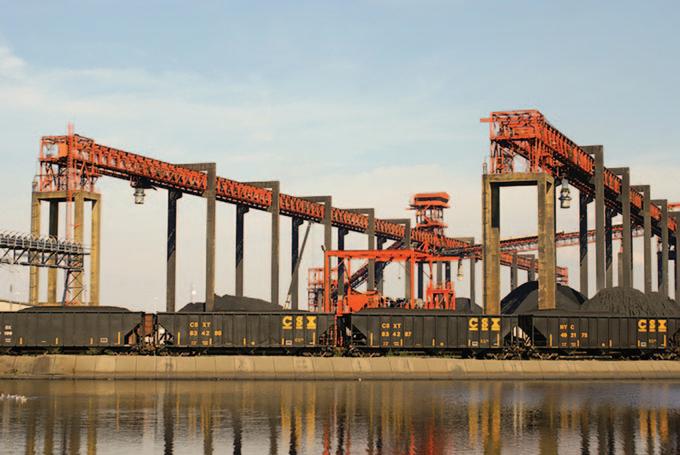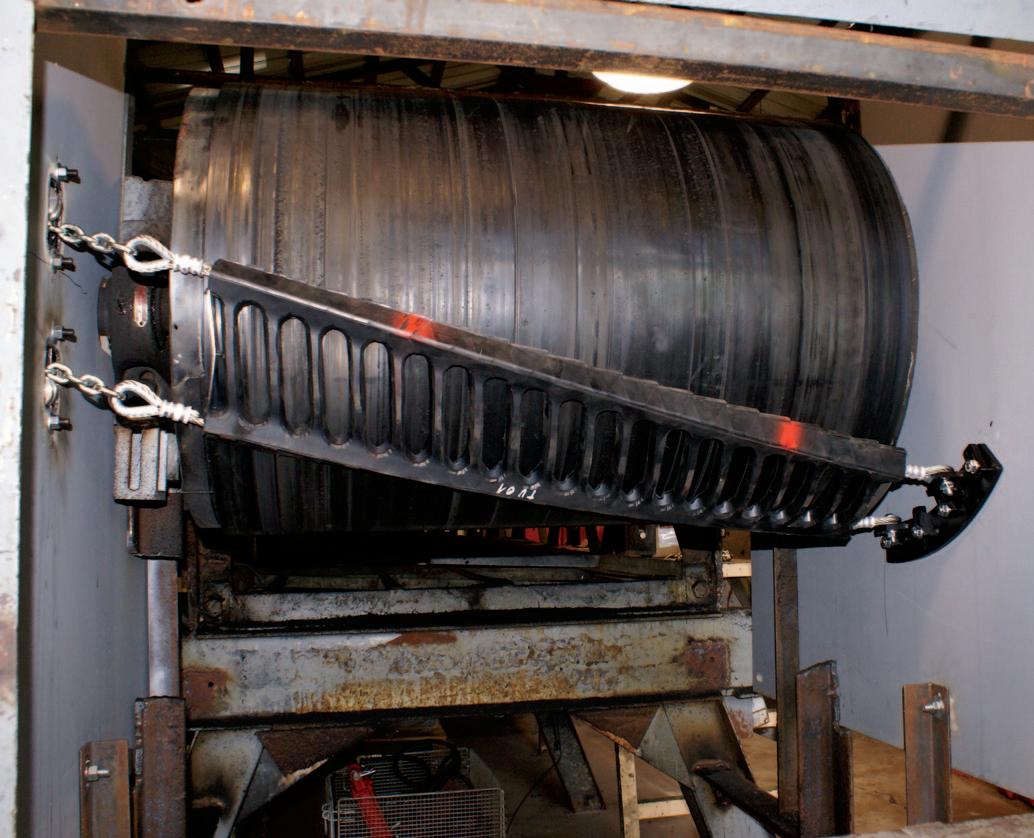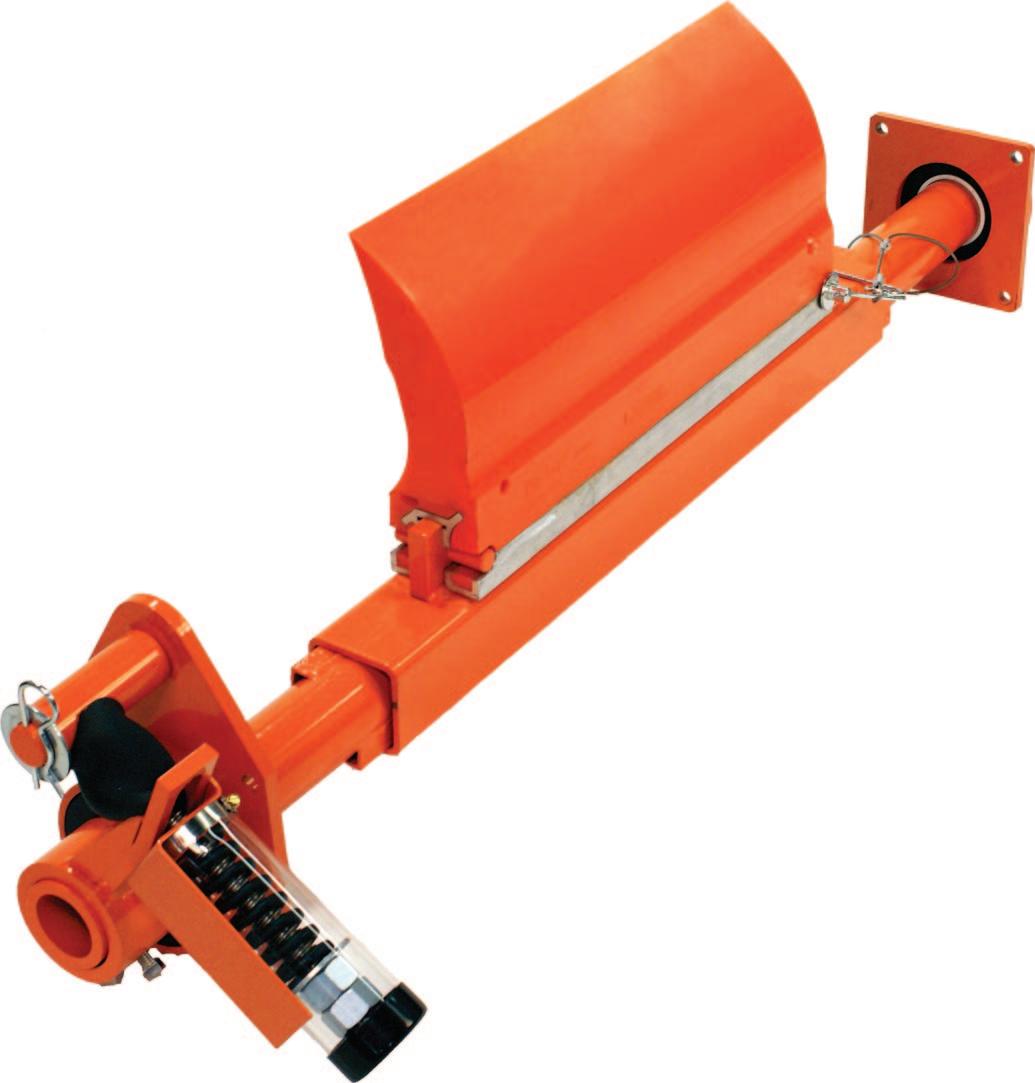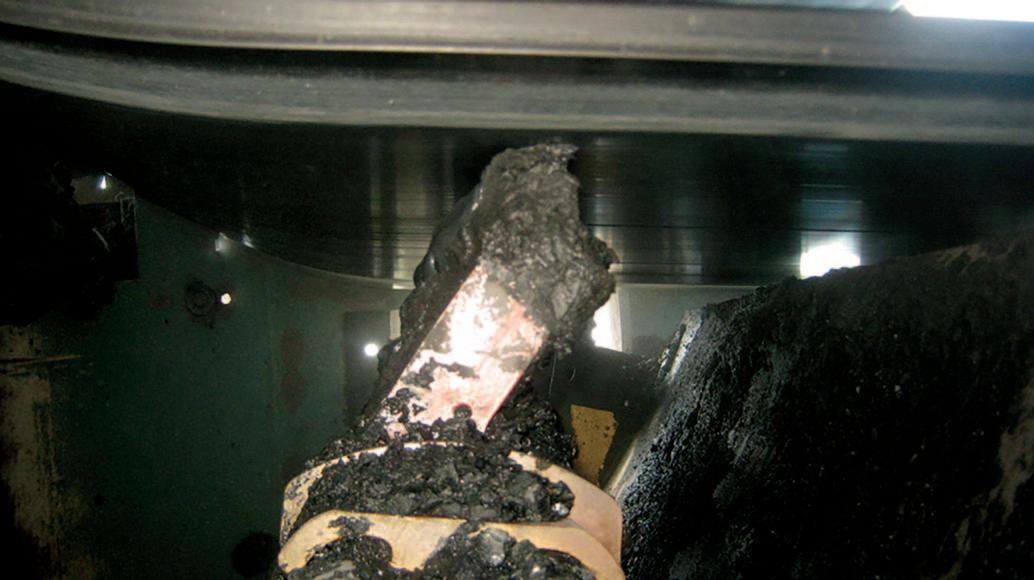
7 minute read
Discharge the dust: effective belt cleaning at coal terminals
The bulk handling process at coal terminals introduces several opportunities for raw and processed coal to be exposed to the elements and emit dust, write Todd Swinderman, President Emeritus, Martin Engineering and Dan Marshall, Process Engineer, Martin Engineering. From truck/train offloading, storage in piles or silos, to loading onto barges or into the cargo hold of a ship, the material generally passes through several conveyor transfers, potentially shedding dust at every step.
One of the most highly regulated particulate emissions of any bulk handling material is Respirable Crystalline Silica (RCS), which is prevalent in coal dust. The fact that particle sizes for the substance are tested in micrometers (one thousandth of a millimetre) and volumes are monitored in micrograms (one millionth of a gram) makes controlling the fugitive dust at coal terminals a significant challenge. Often, these terminals are located near waterways, which can have high winds that carry fine coal dust long distances.
Although there are many opportunities for dust emissions, this article covers fugitive dust at the discharge point of the conveyor transfer where cargo leaves the belt. It discusses how proper belt cleaning can mitigate emissions from carryback and control spillage, improving efficiency and compliance.
Dust Control Reaches Beyond Mere Compliance
Large amounts of emissions at a discharge can cause piles of dust to settle on every surface creating an unpleasant and possibly hazardous work environment. Working in a dusty atmosphere reduces worker productivity — in some studies as much as 20% — if respirators must be worn. The leading cause of death in the coal industry is disease, not accidents. Respiratory illness from exposure to even nuisance dust often leads to workers being put on long-term disability, increasing worker compensation costs. A dirty operation also attracts the attention of regulators and neighbours. A reputation as a ‘dirty place to work’ reduces the pool of employees who are willing to work in such an environment, and those already employed often suffer from low morale.
Coal terminals can be complicated processes that require several dust solutions (all photos copyright Martin Engineering 2023).

Fugitive materials are often a root cause of catastrophic events. Many types of dust present fire and explosion risks in addition to health and safety concerns. The destructive power of dust explosions is well documented in the coal industry. Static discharge into a dusty atmosphere is a common cause of many of these fires and explosions. Dust can foul components that create hazards. Friction from a seized idler due to fouling is a common root cause of major incidents. In many cases, a frozen idler bearing is the heat source that ignites the grease which catches fire.
Uncontrolled Material Flow
Efficient throughput is all about controlling the cargo stream and proper discharge is at the heart of that control. The nature of fugitive material problems from any conveyor is indicated by the location and particle sizes of the accumulations. Fugitive materials at the discharge zone are generally categorized into spillage, dust and carryback.
Spillage is cargo that escapes the belt v and accumulates on either side of the conveyor. Piles are formed rapidly and can occur from inadequately maintained transfer points. Dust is the fine particles, usually less v than the diameter of a human hair in size, that are created as the bulk material moves through a conveyor system. Fine airborne dust is emitted at locations where the cargo is exposed or disrupted. Because dust particles are very small, when dry, they are easily dispersed. Carryback is fine material that sticks v to the belt surface or becomes lodged in the cracks and crevices of the carrying side of the belt. Carryback material collects on components that the carrying side of the belt touches and eventually dries out, dropping beneath the system along the return path.

Coal dust can be mitigated by ensuring as much cargo as possible remains in the discharge stream.

Belt Cleaning Innovations Mean Less Dust
The design and function of belt cleaners have come a long way. In the past, belt cleaners were rigid, linear pieces of hardware made out of various materials from brick to plastic that earned the name ‘scrapers’ or ‘wipers’ because that is what they did. They had a low operational life, broke or cracked frequently and contributed significantly to belt wear.
Modern primary cleaners are usually mounted at the head pulley and made from engineered polyurethane. This specially formulated material is forgiving to the belt and splice, but still highly effective for dislodging cargo. Typically supported by mechanical or pneumatic tensioners, the designs require significantly less monitoring and maintenance of blade tension.

One primary cleaner design requires no tensioning at all after initial installation. The CleanScrape® Primary Cleaner features a matrix of tungsten carbide scrapers installed diagonally to form a threedimensional curve around the head pulley and typically delivers up to 4x the service life of urethane cleaners without ever needing re-tensioning.
As conveyor speeds and cargo volumes increase to meet production demands, secondary belt scrapers are often installed immediately after the belt leaves the head pulley to address dust and fines that escape the primary cleaner. Generally equipped with spring or air tensioners that easily adjust to fluctuations in the belt, secondary cleaners are particularly efficient for applications that produce wet, tacky or dusty carryback.
The CleanScrape® Secondary Cleaner takes a different approach from the standard secondary cleaner. It features independent six-inch wide blades with carbide tips set on a stainless steel assembly. Each tip is supported on springloaded arms at both ends with a wide range of motion that provides equal load pressure across each blade and requires less tensioning over its lifespan. This design absorbs obstructions, responds to belt fluctuations, and is able to arc safely in the event of a belt rollback.
The Martin® SHD 600 Primary Cleaner can use a spring tensioner for steady pressure across the belt profile.
Coal Terminal Case Study
The coal terminal operated by PT. Indominco Mandiri in Bontang, Indonesia was experiencing excessive carryback along its C26 and C27 conveyor system. With a cargo volume of 6,000mtph [metric tonnes per hour (6,613tph [tonnes per hour]), the coal was not being completely discharged and clung onto the return side of the belt. All along the return path, material would dislodge and collect on the floor and around the mainframe. The volume of spillage was large enough that the managers contracted outside help for cleanup. The spillage raised the cost of operation, and cleanup around the moving conveyor system increased the chance of worker injury.
Martin technicians inspecting the conveyor system recommended a Martin® SHD 600 Primary Cleaner and Martin® DT2 Inline Secondary Cleaner for the 800 mm (30in.) head pulley to resolve the carryback issue. Designed for pulleys smaller than 120cm (48in.), belts from 1,066–3,000mm (42–120in.), and operating speeds up to 10mps (2,000fpm), the SHD uses a continuous angle curved blade for effective cleaning and extended blade life. Suited for medium to heavy-duty applications, the DT2 slide-in/slide-out belt cleaner blade cartridge allows fast and safe blade service. Working in tandem, the units clean sticky carryback and introduce it back into the discharge flow.
After one year of operation, plant managers report a drastic decrease in carryback resulting in less spillage. Reduced cleanup time has lowered the cost of operation and lessened the amount of time workers spend around a running conveyor, creating a safer workplace. “We are very satisfied with the results,” said Mr. Iwan of PT. Indominco Mandiri. Operators say the company now plans to install an SHD 600 primary and DT2H secondary cleaner on the tripper conveyor located at the plant’s stacker/reclaimer.
Conclusion
When fines are allowed to cling to the return side of the belt, suddenly dust can be detected along the entire length of the system. Spillage beneath the system is exposed to wind and adds to the dust. These fugitive emissions can cost coal terminals in violations and potential lawsuits.

Innovations in both blade design and tensioner engineering have improved cleaning ability, increased equipment life, reduced the need for tensioning and blade changes, and decreased labor for maintenance and cleanup. Along with lowering the cost of operation, the most noticeable change is less dust along the belt path and in work areas. This improves employee morale and retention and results in better compliance.
About The Authors
R. Todd Swinderman earned his B.S. from the University of Illinois, joining Martin Engineering’s Conveyor Products division in 1979 and subsequently serving as V.P. and General Manager, President, CEO and Chief Technology Officer. Swinderman has authored dozens of articles and papers, presenting at conferences and customer facilities around the world and holding more than 140 active patents. He has served as President of the Conveyor Equipment Manufacturers’ Association and is a member of the ASME B20 committee on conveyor safety. Swinderman retired from Martin Engineering to establish his own engineering firm, currently serving the company as an independent consultant.
Daniel Marshall received his Bachelor of Science degree in Mechanical Engineering from Northern Arizona University. With nearly 20 years at Martin Engineering, Marshall has been instrumental in the development and promotion of multiple belt conveyor products. He is widely known for his work in dust suppression and considered a leading expert in this area. A prolific writer, Marshall has published over two dozen articles covering various topics for the belt conveyor industry; he has presented at more than fifteen conferences and is sought after for his expertise and advice. He was also one of the principal authors of Martin’s FOUNDATIONS™ The Practical Resource for Cleaner, Safer, and More Productive Dust & Material Control, Fourth Edition, widely used as one of the main learning textbooks for conveyor operation and maintenance.
About Martin Engineering
Martin Engineering has been a global innovator in the bulk material handling industry for more than 75 years, developing new solutions to common problems and participating in industry organizations to improve safety and productivity. The company’s series of Foundations books is an internationally recognized resource for safety, maintenance and operations training — with more than 22,000 print copies in circulation around the world. The 500+ page reference books are available in several languages and have been downloaded thousands of times as free PDFs from the Martin website. Martin Engineering products, sales, service and training are available from 16 factoryowned facilities worldwide, with whollyowned business units in Australia, Brazil, China, Colombia, France, Germany, India, Indonesia, Italy, Mexico, Peru, Spain, South Africa, Turkey, the USA and UK. The firm employs more than 1,000 people, approximately 400 of whom hold advanced degrees.










